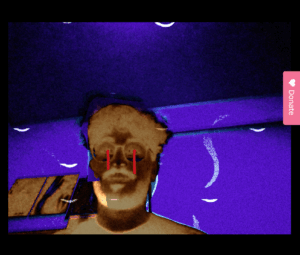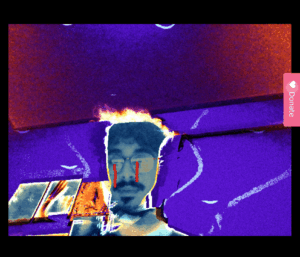What is Music Vent?
So I created this music visualizer called **Music Vent**, and the whole idea came from thinking about how we use music when we’re feeling emotional – especially when we’re sad or need to vent. You know how sometimes you just want to put on some music and let it all out? That’s exactly what this project is about.
The point of Music Vent is to create an immersive experience for music listening, especially for those moments when you want to vent through sad music. But here’s the thing – while you’re going through those emotions, there are these cute, colorful elements that somehow bring you ease and comfort.
The Concept Behind It:
I wanted to capture this duality that happens when we listen to music emotionally. On one hand, you have these really comforting, almost therapeutic elements:
– **Flying radio-cloud birds**: These little radios attached to clouds that float across the screen in the most adorable way. They’re like digital companions that keep you company while you’re listening.
– **A beautiful galaxy background**: I created this artistic Milky Way galaxy with twinkling stars and colorful dust clouds that creates this peaceful, cosmic atmosphere.
– **Soft colors and smooth animations**: Everything flows gently and uses calming colors that make you feel at ease.
But then on the other hand, you have the more intense, cathartic elements:
– **Beat-responsive visualizations**: These are the NCS-style spectrum analyzers (those green bar graphs you see in the middle) that react aggressively to the music’s beats. They can feel a bit disruptive to the peaceful vibe, but that’s intentional – they represent the raw emotional energy you’re releasing.
How I Built It
The Technical Setup
I built this using p5.js and JavaScript, and I tried to keep the code organized using classes so it wouldn’t become a complete mess. Here’s basically how it’s structured:
“`class MusicVisualizerApp {
constructor() {
this.audioManager=newAudioManager();
this.visualManager=newVisualizationManager();
this.uiManager=newUIManager();
}
}“`
I have separate managers for handling the audio, the visuals, and the user interface. This way, if I want to change how the audio analysis works, I don’t have to mess with the visual code.
The Audio Analysis Part
This was probably the trickiest part. I needed the system to actually “understand” the music and respond to it emotionally. So I created this mood detection algorithm:
“`javascript
class MoodProfile {
analyzeMood() {
constavgEnergy=this.average(this.analysisBuffer.map(d=>d.energy));
constavgBass=this.average(this.analysisBuffer.map(d=>d.frequencyBands.bass));
constavgHigh=this.average(this.analysisBuffer.map(d=>d.frequencyBands.high));
// Calculate emotional characteristics
this.currentMood.energy=Math.min(avgEnergy*2, 1.0);
this.currentMood.danceability=Math.min((avgBass+this.currentMood.energy) *0.8, 1.0);
this.currentMood.valence=Math.min((avgHigh+avgCentroid) *0.9, 1.0);
}
}
“`
Basically, the system listens to the music and analyzes different frequency bands – like how much bass there is, how much high-frequency content, the overall energy level. Then it tries to figure out the “mood” of the song and adapts the visuals accordingly.
The cool thing is that it can detect beats in real-time and make the black hole effect happen right when the beat hits. I spent way too much time getting the beat detection algorithm right!
Creating the Galaxy Background
I wanted something that felt cosmic and peaceful, so I created this Milky Way galaxy effect. It has about 500 twinkling stars, colorful dust clouds, and these spiral arms that slowly rotate. But here’s the cool part – when a beat hits in the music, the whole galaxy gets sucked into a black hole!
“`javascript
// When beats are detected, everything spirals inward
if (beatDetected) {
this.targetBlackHoleIntensity=1.0;
// Stars and particles get pulled toward the center
}
“`
The black hole effect was inspired by how intense emotions can feel like they’re pulling everything into them. When the beat drops, you see this dramatic transformation where all the peaceful elements get drawn into this swirling vortex with orange and purple colors.
### The Flying Radio-Cloud Birds
This was probably my favorite part to code. I took inspiration from a radio drawing I had made before and turned it into these little geometric radios that fly around attached to fluffy clouds. They spawn randomly from either side of the screen and just float across peacefully.
“`javascript
class RadioCloudBird {
constructor(x, y, direction=1) {
this.cloudColor=random([‘white’, ‘lightblue’, ‘pink’, ‘purple’]);
this.radioColor=random([‘brown’, ‘black’, ‘silver’, ‘gold’]);
this.bobSpeed=random(0.02, 0.05); // Makes them bob gently
}
}
“`
Each radio is drawn using basic geometric shapes – rectangles for the body, circles for the speakers and knobs, lines for the antenna. I had to figure out how to scale everything properly so they’d look right when flying around, but once I got it working, they became these adorable little companions that make the whole experience feel less lonely.
## What I Learned and Challenges I Faced
### Making Everything Feel Smooth
One thing I really focused on was making sure all the animations felt organic and not jarring. I used a lot of interpolation to smooth out the transitions:
“`javascript
// Instead of sudden changes, everything gradually transitions
this.values.bass = lerp(this.values.bass, newBassValue, 0.1);
this.values.energy = lerp(this.values.energy, newEnergyValue, 0.1);
“`
This makes the whole experience feel more natural and less like you’re watching a computer program.
### A Small Touch: Conversation Detection
I also added this feature where if the system detects you’re talking (through the microphone), it automatically lowers the music volume. I Included this interactivity feature because that one feature I really wished to see in music party listening softwares. As someone who used to listen to music bots a lot on discord a lot, I always found it annoying to manually reduce or mute the music bot whenever I wanna speak to my friends while listening. This was the initial inspiration to create this project by the way, but then I got the idea of the concept behind this visualizing experience so I focused more on it.
Here is the project on p5, have fun experiencing it!




